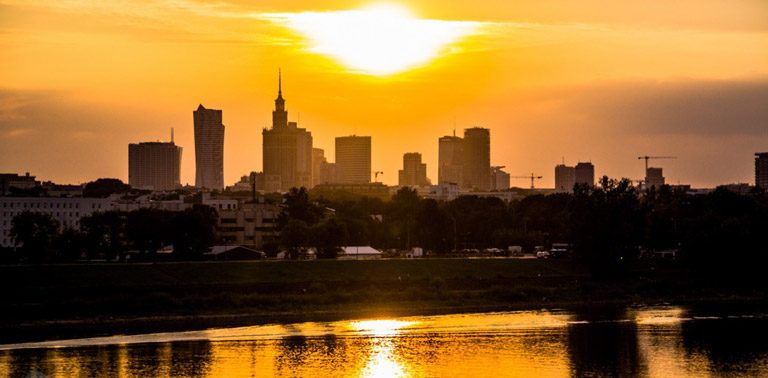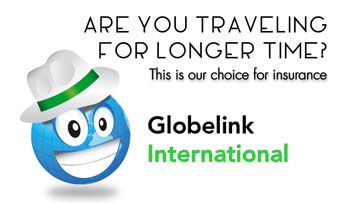
Road trip through Poland and visiting Auschwitz
In this post we sum up our 10 days travels in Poland in mid-August. As explained in the previous road trip post about Via Baltica, we started our travels in Poland from the small town of Augustow in the northeast. After that we drove to Warsaw for a bit longer stay. The drive was somewhat slow due to traffic jams caused by massive road constructions. It seems that new highways are built around the capital, to move the traffic away from the old, slow roads that go through small towns.
Warsaw
We had really shortly visited the capital back in 2007, basically just to change mode of transportation from bus to train on our way to Krakow. Based on that experience and some stories from other travelers, we somehow thought that the capital city is more or less just big and unattractive, with no historical buildings or character. This preconception proved to be wrong, as we found the city to be lively and charming. It is of course true, that nearly the whole city center was destroyed during WWII, but since enormous amount of reconstruction work has been done, actually by using as much of the old bricks as possible, the Stare Miasto (old town) with its narrow streets has quite authentic atmosphere.
We were staying in Wola area, in a budget hostel called Sokolowa 10, which outside of summer season works as Erasmus student apartment. That set up suited for us just perfectly, since there were desks and chairs in the room and strong wifi connection. So we got some work done, and on the side got to know the city. For digital nomads there are several possibilities to use co-working spaces, if working from a hostel room is not a suitable option. Most of the co-working places are meant for bit longer stays, and there are some monthly fees/rents. For shorter stays there are several comfy cafes that are equipped with decent working areas. We took a peak at a place called Labour Cafe, and for sure could have spent some hours with laptops there.
Wola area is about 4 kilometers out of the city center / old town, and there are couple of big parks (Moczydlo and Szymanskiego) close to Sokolowa hostel. Those offer close to perfect conditions for running, and there even is an outdoor fitness area. We also also found a gym nearby, and even managed to get single entries free of charge. To keep things balanced, we visited several nice restaurants and pubs both in the center and along the Vistula river, and had a good night out in a really groovy bar serving delicious craft beers.
Katowice
After Warsow our next stop was Katowice, which is the tenth largest city in Poland with population of bit over 300 000. There was no special purpose for the visit, mainly chose Katowice because it was conveniently both on the way to Slovakia and close to Auschwitz-Birkenau memorial. We ended up staying longer than planned, since once again we found a budget hostel (Klimczoka 6) with decent wifi and desks just couple of kilometers out of city center.
As the weather was cloudy and rainy for couple of days, we mostly focused on writing and developing the site. On third day of our visit we finally headed to the city center. It was nice, but not nearly as beautiful as Krakow for example, partly a bit run-down even. Pedestrian zone with some handsome buildings around it was pleasant, and we found an excellent vegetarian lunch restaurant, strong recommendation to Zloty Osiol! Delicious mains with salad cost a bit over 3 € and 0,5 liter carafe of wine was 3,5 €.
We checked from the map, that there was a huge park area close to our hostel, and of course went for a run there. And what kind of a park it was! Silesia park is an impressive complex with an amusement park in one corner, zoo in another, planetarium, stadium, cable railway and plenty of cafes, restaurants and ice cream kiosks. There are also several garden areas, ponds, awesome plantings and crisscrossing paved passages everywhere. It seemed to be a popular site for evening strolls and jogging, no wonder. Check it out if you ever visit Katowice!
Visiting Auschwitz-Birkenau
When leaving Katowice behind, we spent a day visiting the infamous Auschwitz-Birkenau Memorial and Museum. By chance it was August 23rd, The European Day of Remembrance for Victims of Stalinism and Nazism, also known as the Black Ribbon Day. It is possible to visit this former concentration and extermination camp free without a guide (during the summer months only if arriving to the gates by 9 am or after 4 pm). We usually are not big fans of any guided tours or entrance fees, but in Auschwitz the tour really was worth it (45 PLN, so around 11 €).
The tour takes about three hours in total, and it includes a shuttle bus ride from Auschwitz I to Auschwitz II – Birkenau and back. There are English tours starting every hour or so, and safest bet is to book it in advance from the website of the memorial and museum. We managed to get places in English tour without reservation, but needed to wait for hour and half.
Good walking shoes are recommended, and in warm weather you should carry some water with you. Eating and smoking is forbidden in the memorial area. Parking next to the gates costs 2,5 euros, but it is possible to find free parking not that far away from the site.
Visiting these sites was quite an emotional experience. What happened in these premises is gruesome beyond all limits, and walking around and exploring these memorials leaves you pretty much speechless. Pictures in the gallery tell part of the story. Recommendation to visit.
First bite of Slovakia
Next destination on this European tour is Slovakia, one of the rare European countries we hadn’t visited before. We started with longish drive (again with road constructions in Poland side) to the capital city Bratislava. The main goals for our stay in the country are the mountains and national parks, but wanted to spend couple of days in Bratislava too.
Travel stories from Slovakia will follow after some hiking adventures have been completed!






